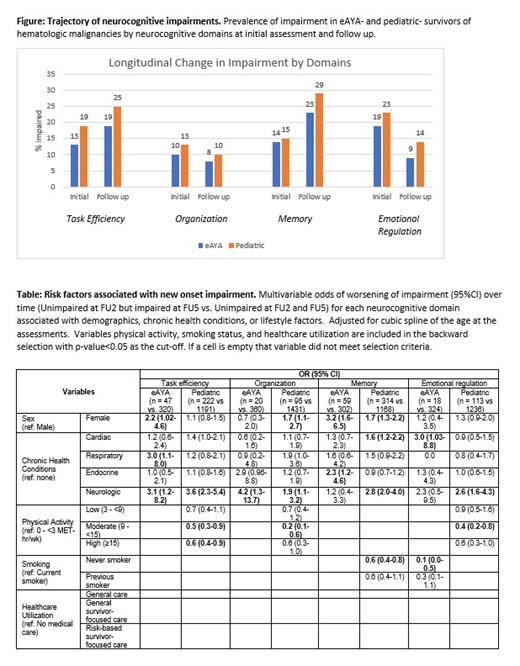Background:
Survivors of hematologic malignancies diagnosed during adolescence and early young adulthood (eAYA survivors) experience neurocognitive impairments as a result of intensive neurotoxic therapies, but the trajectory of these impairments as survivors age are not known. We examined longitudinal changes in neurocognitive outcomes in eAYA survivors compared to younger survivors and sibling controls.
Methods:
We identified 421 eAYA (diagnosed at 15-21 years) and 1758 pediatric (diagnosed at <15 years) survivors of ALL, AML, and Hodgkin lymphoma (HL), as well as 233 siblings from the Childhood Cancer Survivor Study (>5 year survivors diagnosed 1970-1999) who completed the Neurocognitive Questionnaire (NCQ) at two follow-up surveys (i.e. FU2, FU5) administered 11 years apart. Impairment was defined as a score in the worst 10% of the sibling cohort in task efficiency (TE), organization (Org), memory (Mem), and emotional regulation (ER) domains. Linear regression analysis was performed to estimate the change in neurocognitive T-scores and to identify factors associated with the changes, adjusting for age at initial (FU2) assessment and baseline T-score. The frequency of new onset impairments and associated risk factors were analyzed, specifically to identify survivors who had 1) neurocognitive improvement, ie. impaired at FU2 and became unimpaired vs. remained impaired on FU5, and 2) neurocognitive worsening, ie. unimpaired at FU2 and became impaired vs. remained unimpaired at FU5. Multivariable logistic analysis was performed to identify treatment exposures and chronic health conditions (CHCs) associated with the development or resolution of impairment. Smoking, physical activity, and healthcare utilization were examined as additional risk factors.
Results:
Compared to siblings, NCQ T-scores worsened over time for both survivors of eAYA (estimated mean score Δ1.9, range 0.5-3.4, p=0.01 in TE; Δ3.0, range 1.5-4.6, p<0.001 in Mem) and pediatric (estimated mean score Δ3.2, range 2.0-4.5, p<0.001 in TE; Δ1.3, range 0.1-2.5, p=0.03 in Org; Δ3.8, range 2.6-5.0, p<0.001 in Mem; Δ2.8, range 1.5-4.1, p<0.001 in ER) malignancies. Risk factors for worsening scores over time in eAYA survivors included having a neurologic CHC (TE: Δ4.9, 95% CI 1.7-8.1; ER: Δ4.2, 95% CI 0.9-7.4), receiving ≥35Gy chest radiation therapy (RT) (TE: Δ4.0, 95% CI 1.7-6.2; Mem: Δ3.3, 95% CI 1.2-5.4), receiving cranial RT (TE: Δ4.0, 95% CI 0.9-7.1; Mem: Δ5.7, 95% CI 2.7-8.7; ER: Δ3.4, 95% CI 0.5-6.4), and being female (Mem: Δ2.8, 95% CI 1.3-4.3). Being a never smoker was associated with improved scores over time in all domains (Δ range -3.2- -6.3). In the new onset impairment analysis, prevalence of TE and Mem impairments increased while Org and ER impairments decreased over time in eAYA and pediatric survivors ( Figure). Factors associated with new onset impairment in eAYA survivors included female sex (Mem: OR 3.2, 95% CI 1.6-6.5), cardiac CHC (ER: OR 3.0, 95% CI 1.03-8.8), respiratory CHC (TE: OR 3.0, 95% CI 1.1-8.0), endocrine CHC (Mem: OR 2.3, 95% CI 1.2-4.6), and neurologic CHC (TE: OR 3.1, 95% CI 1.2-8.2; Org: OR 4.2, 95% CI 1.3-13.7) ( Table). Corresponding CHC-associated impairments were not seen in pediatric survivors, except for neurologic CHC. In a separate model of treatment exposures, eAYA survivors who received salvage HL therapy (Mem: OR 4.8, 95% CI 1.5-15.3), ≥35Gy chest RT (Mem: OR 3.7, 95% CI 1.7-8.2; TE: OR 2.6, 95% CI 1.1-6.1), and cranial RT (Mem: OR 3.4, 95% CI 1.2-9.8; ER: OR 5.3, 95% CI 1.2-22.5) were more likely to experience new onset neurocognitive impairment. While being a never smoker was associated with a decreased odds of new onset impairment (ER: OR 0.1, 95% CI 0.0-0.5), no factors associated with resolution of impairment were found in eAYA survivors.
Conclusions:
Survivors of eAYA hematologic malignancies experience declining neurocognitive function as well as new onset impairments over time. Memory was the most affected domain. Risk factors for worsening impairment include being female, health comorbidities, and intensive treatment exposures, such as salvage therapy, high-dose chest RT, and cranial RT. Comorbidities may play a larger role in mediating new onset neurocognitive impairments in eAYAs than pediatric survivors. Future studies should focus on characterizing outcomes across the entire AYA age spectrum.
Disclosures
Stock:Kite: Consultancy; Kura: Research Funding; Servier: Other: Data Safety Monitoring Board/Advisory Board; Newave: Honoraria; Amgen: Honoraria; Jazz Pharmaceuticals: Consultancy, Honoraria; Glaxo Smith Kline: Consultancy.


This feature is available to Subscribers Only
Sign In or Create an Account Close Modal